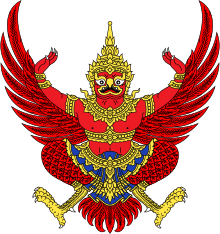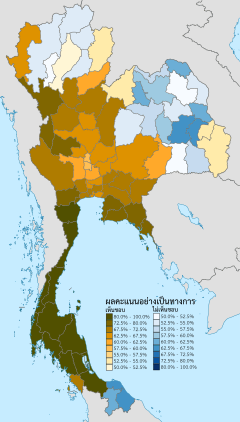Thai constitutional referendum, 2016
| Thai constitutional referendum, 2016 | |
|---|---|
|
1) Do you approve or disapprove of the draft constitution? 2) Do you approve that for contributing continuity of the country reform according to the national strategic plan, it should be stipulated in the Transitory Provisions of the Constitution of the Kingdom of Thailand that for the duration of 5 years from the first sitting of the National Assembly under this constitution; the joint sitting of the two chambers of the National Assembly shall convene to consider approving a person to be appointed as the Prime Minister?[1] | |
|
Provinces of Thailand colored according to referendum results regarding the constitution. | |
| Location | Thailand |
| Date | 7 August 2016 |
| Draft constitution | |
| Election of the Prime Minsiter | |
 |
| This article is part of a series on the politics and government of Thailand |
|
|
|
|
|
A constitutional referendum was held in Thailand on 7 August 2016. The charter offered only semi-democracy and was seen to tighten military rule in Thailand.[2] However, it was approved by 61% of voters with a 59% turnout. A second proposal for the next Prime Minister to be jointly elected by Senators and MPs was also approved.
Constitutional drafting
The primary difference between the 2016 constitution and the 2007 document was that the Senate would become a fully appointed chamber rather than a partially elected one during the 5 year "transitional period" stipulated in the charter. This was seen as an effort by the National Council for Peace and Order (NCPO) to retain influence once it has left office, as it will have the right to appoint the 250 members.[3] The Senate would also be granted veto power over the House of Representatives on amending the constitution, and a Prime Minister will be allowed to be appointed from outside either house.
Conduct
The NCPO banned criticism of the draft constitution and prohibited monitoring of the referendum. Activists against the document were arrested, detained, and prosecuted in military courts,[4] whilst voters who expressed their intention to vote against the draft were also arrested and prosecuted by the military regime.[5]
350,000 canvassers were scheduled to be trained by the Constitutional Drafting Committee to campaign for the constitution, approximately four per village.[6]
Results
| Question | For | Against | Invalid/ blank |
Total votes |
Registered voters |
Turnout | ||
|---|---|---|---|---|---|---|---|---|
| Votes | % | Votes | % | |||||
| Draft charter | 16,820,402 | 61.35 | 10,598,037 | 38.65 | 2,322,238 | 29,740,677 | 50,071,589 | 59.40 |
| Election of the Prime Minister | 15,132,050 | 58.07 | 10,926,648 | 41.93 | 3,681,979 | |||
| Source: Bangkok Post | ||||||||
Results by Provinces: Draft Charter
| Provinces | Votes For | % | Votes Against | % | Invalid/
blank |
Total votes | Registered
voters |
Turnout |
|---|---|---|---|---|---|---|---|---|
| Ang Thong | 70,958 | 58.84 | 49,641 | 41.16 | 4,914 | 131,503 | 225,231 | 58.39% |
| Ayutthaya | 216,278 | 60.57 | 140,804 | 39.43 | 14,380 | 387,429 | 632,905 | 61.22% |
| Bangkok | 1,585,533 | 69.22 | 705,195 | 30.78 | 36,362 | 2,370,477 | 4,450,224 | 53.27% |
| Chai Nat | 93,967 | 64.05 | 52,738 | 35.95 | 6,372 | 161,692 | 265,183 | 60.97% |
| Chachoengsao | 204,136 | 68.79 | 92,616 | 31.21 | 10,494 | 321,981 | 540,441 | 59.58% |
| Chanthaburi | 176,029 | 74.74 | 59,485 | 25.26 | 7,918 | 253,531 | 412,681 | 61.44% |
| Chonburi | 430,361 | 76.45 | 132,554 | 23.55 | 14,888 | 595,684 | 1,094,654 | 54.42 |
| Kanchanaburi | 226,825 | 68.71 | 103,288 | 31.29 | 13,171 | 360,497 | 617,725 | 58.36% |
| Lopburi | 205,619 | 64.22 | 114,528 | 35.78 | ||||
| Rayong | 221,196 | 78.68 | 59,932 | 21.32 | ||||
| Ratchaburi | 291,475 | 75.38 | 95,214 | 24.62 | ||||
| Nakhon Nayok | 76,566 | 70.63 | 31,839 | 29.37 | ||||
| Nakhon Pathom | 271,394 | 68.64 | 124,018 | 31.36 | ||||
| Nonthaburi | 343,771 | 67.37 | 166,490 | 32.63 | ||||
| Pathum Thani | 278,265 | 62.93 | 163,918 | 37.07 | ||||
| Prachuap Khiri Khan | 186,361 | 82.93 | 38,355 | 17.07 | ||||
| Prachinburi | 148,567 | 69.01 | 66,701 | 30.99 | ||||
| Sa Kaeo | 156,955 | 71.16 | 63,617 | 28.84 | ||||
| Saraburi | 193,686 | 63.27 | 94,224 | 36.73 | ||||
| Samut Prakan | 318,571 | 65.50 | 167,798 | 34.50 | ||||
| Samut Sakhon | 152,465 | 72.05 | 59,159 | 27.95 | ||||
| Samut Songkhram | 62,948 | 77.40 | 18,385 | 22.60 | ||||
| Sing Buri | 56,446 | 58.62 | 39,840 | 41.38 | ||||
| Suphan Buri | 223,114 | 60.81 | 143,798 | 39.19 | ||||
| Trat | 72,469 | 79.41 | 18,790 | 20.59 | ||||
| Central Region | 6,551,370 | 69.43 | 2,883,907 | 30.57 | 274,800 | 10,050,982 | 17,580,470 | 57.17% |
| Chumphon | 208,068 | 90.04 | 23,004 | 9.96 | ||||
| Krabi | 161,520 | 83.99 | 30,787 | 16.01 | 5,086 | 205,052 | 330,771 | 61.99% |
| Nakhon Sri Thammarat | 559,689 | 88.05 | 75,927 | 11.95 | ||||
| Narathiwat | 109,348 | 36.04 | 194,020 | 63.96 | ||||
| Pattani | 89,952 | 35.02 | 166,900 | 64.98 | ||||
| Phang Nga | 97,952 | 84.23 | 18,344 | 15.77 | ||||
| Phatthalung | 213,900 | 84.55 | 39,087 | 15.45 | ||||
| Phuket | 125,643 | 88.03 | 17,081 | 11.97 | ||||
| Ranong | 64,234 | 87.10 | 9,512 | 12.90 | ||||
| Satun | 91,835 | 70.20 | 38,986 | 29.80 | ||||
| Songkhla | 506,752 | 82.26 | 109,283 | 17.74 | ||||
| Surat Thani | 377,628 | 87.29 | 54,980 | 12.71 | ||||
| Trang | 250,644 | 86.19 | 40,170 | 13.81 | ||||
| Yala | 81,759 | 39.93 | 122,988 | 60.07 | ||||
| Southern Region | 2,938,924 | 75.75 | 941,049 | 24.25 | 142,750 | 4,179,401 | 6,773,033 | 61.71% |
| Chiang Mai | 390,046 | 45.92 | 459,399 | 54.08 | ||||
| Chiang Rai | 249,684 | 45.02 | 304,976 | 54.98 | ||||
| Lampang | 193,758 | 51.72 | 180,863 | 48.28 | ||||
| Lamphun | 109,495 | 48.08 | 118,258 | 51.92 | ||||
| Phrae | 102,745 | 46.21 | 119,594 | 53.79 | ||||
| Nan | 122,142 | 52.83 | 109,057 | 47.17 | ||||
| Mae Hong Son | 69,439 | 64.18 | 38,757 | 35.82 | ||||
| Tak | 160,674 | 72.69 | 60,377 | 27.31 | ||||
| Uttaradit | 124,356 | 60.27 | 81,982 | 39.73 | ||||
| Phitsanulok | 265,136 | 68.96 | 119,348 | 31.04 | ||||
| Kamphaeng Phet | 217,926 | 71.84 | 85,354 | 28.14 | 12,662 | 334,102 | 508,758 | 65.67% |
| Nakhon Sawan | 289,393 | 67.01 | 142,471 | 32.99 | ||||
| Sukhothai | 188,608 | 70.25 | 79,598 | 29.75 | ||||
| Phetchabun | 286,163 | 69.20 | 127,342 | 30.80 | ||||
| Phichit | 141,330 | 65.33 | 75,000 | 34.67 | ||||
| Uthai Thani | 106,884 | 74.74 | 36,123 | 25.26 | ||||
| Phayao | 109,408 | 47.15 | 122,649 | 52.85 | ||||
| Northern Region | 3,020,303 | 57.58 | 2,225,285 | 42.42 | 218,944 | 5,788,045 | 8,840,048 | 65.48% |
| Amnat Charoen | 87,314 | 54.69 | 72,346 | 45.31 | ||||
| Buriram | 365,041 | 60.22 | 241,101 | 39.78 | ||||
| Chaiyaphum | 204,055 | 45.63 | 243,144 | 54.37 | ||||
| Loei | 158,394 | 54.19 | 133,890 | 45.81 | ||||
| Kalasin | 180,465 | 45.03 | 220,317 | 54.97 | 12,693 | 441,164 | 771,851 | 57.16% |
| Khon Kaen | 333,807 | 44.91 | 409,453 | 55.09 | 25,062 | 815,191 | 1,419,106 | 57.44% |
| Maha Sarakham | 172,392 | 42.41 | 234,140 | 57.59 | ||||
| Mukdahan | 56,544 | 37.99 | 92,282 | 62.01 | ||||
| Nakhon Ratchasima | 730,985 | 64.39 | 404,261 | 35.61 | ||||
| Nakhon Phanom | 139,497 | 47.23 | 155,830 | 52.77 | ||||
| Nong Bua Lamphu | 77,167 | 39.75 | 116,958 | 60.75 | ||||
| Nong Khai | 86,557 | 44.29 | 108,874 | 55.71 | ||||
| Roiet | 186,931 | 35.98 | 332,587 | 64.02 | ||||
| Sakhon Nakhon | 217,372 | 47.89 | 236,497 | 52.11 | ||||
| Sisaket | 244,499 | 42.46 | 331,314 | 57.54 | ||||
| Surin | 259,668 | 49.22 | 267,917 | 50.78 | ||||
| Ubon Ratchathani | 413,901 | 54.77 | 341,848 | 45.23 | ||||
| Udon Thani | 248,092 | 40.66 | 362,023 | 59.34 | ||||
| Yasothon | 81,272 | 36.35 | 142,284 | 63.65 | ||||
| North Eastern Region | 4,309,805 | 48.66 | 4,547,776 | 51.34 | 299,715 | 9,722,249 | 16,878,002 | 57.60% |
Sources: http://www.ect.go.th/th/wp-content/uploads/2016/08/ect110816.pdf
Turnout for the vote was at 59%. The vote was rejected in the pro-Thaksin Isan province and even more firmly in the three Muslim majority southern provinces.[7] The ‘Yes’ camp accounted for 61.4 per cent of the voter turn-out, while the ‘No’ faction could garner only 38.6 per cent, with 94 per cent of the votes counted on the day after.[8]
BBC reported that there are many cited reasons for the result, including repression on campaigning and criticizing the charter with only few people actually saw a copy. The drafters argued that it will address political corruption and help reform the country. Some trusted the military junta. Many voters were tired of endless political crisis and saw the charter as a way back to normality.[2]
Aftermath
The next task of the Constitutional Drafting Committee is to draw up organic laws governing the new political system.
Political parties are expected to dissolve themselves and reform, which may end up with smaller parties. The new voting system will make it harder for larger parties to win an overall majority and more likely to form a coalition. Elections can be held as early as next year.[2]
The new government will be subject to supervision by the unelected Senate, as well as other constitutional bodies. Impeachment will be easier and it is possible that a non member of parliament become a prime minister if there is a deadlock. Future governments also required to adhere to 20-year plan of the military.[2]
The military will remain a significant actor in Thai politics for many years, and will stay in power until the royal succession has been completed.[2]
See also
References
- ↑ Referendum Booklet: A Summary of Standing Provisions
- 1 2 3 4 5 "Thai referendum: Why Thais backed a military-backed constitution". BBC. 9 August 2016.
- ↑ "Thailand unveils new constitution draft to public". Deutsche Welle. 23 March 2016.
- ↑ "Thailand: Junta Bans Referendum Monitoring". Human Rights Watch. New York: Human Rights Watch. 2016-06-21. Retrieved 2016-07-05.
- ↑ "ทนายดังมอบตัวสู้คดีทำผิด พ.ร.บ. ออกเสียงประชามติ". Matichon Online (in Thai). Bangkok: มติชน. 2016-07-17. Retrieved 2016-07-17.
- ↑ Chanwanpen, Kasamakorn (25 April 2016). "Scandals may hurt referendum". The Nation. Retrieved 25 April 2016.
- ↑ Thailand votes for a new constitution The Economist, 8 August 2016
- ↑ Maierbrugger, Arno (2016-08-08). "After referendum, Thailand's economic direction unclear | Investvine". Retrieved 2016-08-09.
